Agricultural Commodities, Livestock, & Specialized Crop Prices: Trends and Turnarounds
Prices of commodities, livestock, and specialized crops are important as they impact the economy, food security, rural communities, and the environment. Monitoring and understanding these prices are essential for governments, businesses, and individuals involved in agriculture and for policymakers and researchers studying the economic stability of global food systems.
The Challenge of Providing Safe and Accessible Food for a Healthy Life
In late 2021, a committee appointed by the leadership of the Agricultural and Applied Economics Association developed a white paper on the grand challenge to ensure that all people have safe, affordable, accessible, and acceptable food for leading a healthy and active life.
Underwater, in the Field, and in Our Homes Crops, Climate and Consumers
Climate change presents real threats to U.S. agricultural production, forest resources, and rural economies.
Food Security in the U.S. and Worldwide: What the Data Tell Us About Hunger and Policy
Food security is a fundamental human need which the U.S. has long sought to protect, using a variety of programs guided by key metrics that reflect and contribute to international measurements and global actions.
Why is Trade Freedom Important
Recently the importance of agricultural trade for the United States was discussed which accounts for over one-third of U.S. gross farm income. However, the benefits of trade freedom or having less trade barriers go well beyond a specific industry or country as seen in the graph below.
GSS & C-FARE 2023 Policy Communications Competition
In today’s market, graduate students may seek careers where they are tasked with evaluating policy issues and effectively communicating their results to policymakers and other stakeholders. Therefore, the Graduate Student Section (GSS) and Council on Food, Agricultural & Resource Economics (C-FARE) partner for the 3rd Annual Policy Communications Competition. This competition provides graduate students with an opportunity to gain experience in both written and verbal policy communication.
Food Shopping at Dollar Stores: The Changing Face of Food Retail, and What It Means for Consumers
Dollar stores are the fastest-growing food retailers in the contiguous United States and have doubled their share in rural areas in the past decade.
Where are the jobs in food and agriculture, and how to support students in getting into the workforce?
The barriers and challenges of recruiting and retaining students to focus on agri-food-related jobs come from different perspectives and resource limitations, especially the transition from high school to college
The Implications of Natural Disasters on US Agriculture
Farmers, foresters, and ranchers are unfortunately familiar with the devastation and loss of life and property accompanying a natural disaster caused by an extreme weather event such as a hurricane, drought, or flooding.
Brandt Forum 2023: Opportunities and Challenges for US Agriculture and the Environment
While economists recommend using market incentives, there is the widespread use of regulation to achieve agricultural and environmental resource management objectives. This workshop explores new vantage points to explain this reality, emphasizing political economy, irreversibility, and supply chain perspectives.
Global Food Security: What Have We Learned?
The C-FARE webinar in January focused on global food security, which is a necessary first step towards many other goals of U.S. foreign policy, as well as our humanitarian and environmental objectives
The Economics of Natural Disasters
Climate change increases the probability and ferocity of these extreme events. Thus, a key element of public policy is developing mechanisms to enhance resilience and improve human welfare.
The 2021 Organic Survey: The Growth of Organic Production Continues
Organic production is a sustainable production system that does not involve the use of chemical fertilizers, pesticides, and other artificial agents.














